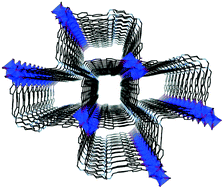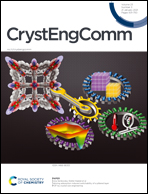Crystal engineering of coordination polymers using flexible tetracarboxylate linkers with embedded cyclohexyldiamine cores†
Abstract
Three new amine functionalised tetracarboxylate linkers with a variety of arm lengths were synthesised, namely N,N,N′N′-tetrakis(R1, R2 or R3)-trans-1,4-diaminocyclohexane, R1 = (4-carboxyphenyl)-1-methyl; R2 = (4-cinnamic)-1-methyl; R3 = 1′-carboxy-[4,4′-biphenyl]-1-methyl. The diagonal length of the linkers, from single crystal structural analysis and obtained by measuring between the furthest oxygen atoms, is 19.4, 24.6 and 27.5 Å for L1, L2 and L3, respectively. The sp3 hybridization of the amino groups of the cyclohexyldiamine core and the carbon atoms of methylene spacers permits the rotation of the attached groups to occur around these atomic sites, giving the ligands a flexibility that manifests itself in two main dominant conformations: convergent, where carboxyl arm groups connected to the same nitrogen atom are π⋯π stacking, and divergent, where two carboxyl arms occupy equatorial positions and two occupy the axial positions relative to the ligand's cyclohexyl core. Analysis of the overall ligand conformations obtained from crystal structures of sixteen new coordination polymers showed that the overwhelmingly most common conformation (93%) was the divergent one. The formulae and topologies of the coordination polymers obtained were: poly-[Cd2(H2L1)(Cl)2(OH2)2]·5H2O (1) 2D (4,4), poly-[M2L2(OH2)2]·DMA M = Cd (2Cd) or Mn (2Mn) 3D (4·62·7·8)(42·66·75·82), poly-[Cd2(L3)(OH2)4(DMF)2] (3) 1D ladder, poly-[Cd2(L3)]·4DMA·16H2O (4) 3D fsc, poly-{((CH3)2NH2)4[Zn4Na4(L1)4(OH2)4(DMF)2]} (5) 3D pts, poly-[M5(HL1)2(O)2(OH2)2(DMF)2]·solv M/solv = Zn/2DMF·18H2O (6Zn) or Co/9DMF·10H2O (6Co) 3D cyc, poly-[Zn3(L1)(OH)2]·2DMF (7) 3D fsc, poly-{((CH3)2NH2)[Zn2(HL2)(O)]·DMF} (8) 3D pts, poly-[Zn8(L3)3(O)2]·16DMF (9) 3D fsy, poly-[Cu2(L1)(DMF)2] (10) 2D (4,4), poly-[Cu2(L2)(OH2)2] (11) 3D lvt, poly-[Na4Zr2(L1)3(DMF)4] (12) 3D (44·52)2(44·5·6)(46·513·68·7)2, poly-[Zr6(HL1)2(O)8(CH3COO)2(OH2)6] (13) 3D scu, and poly-[Co2K4(L1)2(DMF)3] (14) 3D (42·64)(42·610·83). Although we applied similar reaction conditions, none of the coordination polymers obtained with L1, L2 & L3 were isoreticular upon ligand change. The overall trend is of void space increase by using longer ligands but with no notable increase in the level of interpenetration. The predictability and control of the obtained frameworks was hindered by the formation of non-default topologies due to the high flexibility of the tetracarboxylate linkers used and the variety of metal nodes observed.

- This article is part of the themed collection: Coordination Networks


 Please wait while we load your content...
Please wait while we load your content...